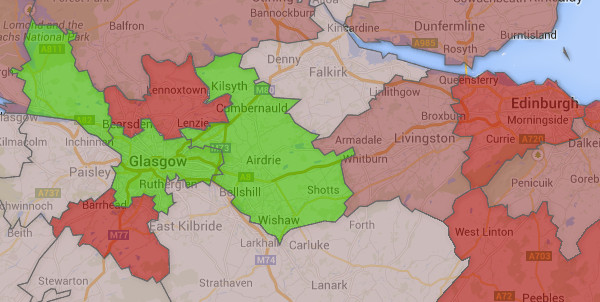This post was written yesterday about Thursday’s Scottish independence referendum. Come back later today for a summary of the New Zealand results.

There was a lot of interesting implications revealed by the pattern of results in Thursday’s Scottish independence referendum.
Firstly, the vote was relatively even across the whole of Scotland. Despite winning in an overwhelming number of council areas (28 out of 32), the ‘No’ campaign only polled just over 55% of the vote. Even in strongly anti-independence areas like Orkney, Shetland and the two council areas on the English border, roughly one third of voters voted for independence.
It was also very interesting to see how much the vote diverged from party identification patterns in Scotland. With no precedent to use for comparison, most analysts assumed that referendum results would follow a similar pattern to the vote for pro-independence parties, but this proved to be completely unfounded.
The SNP has always performed strongly in the Highlands, Angus and the Western Isles, but ‘no’ won in those areas. In contrast, the ‘yes’ case won in the big cities of Glasgow and Dundee. While Dundee has been an SNP stronghold in the past, Glasgow is a very strong area for the anti-independence Labour Party. Both cities have relatively large populations who are poor and isolated from politics, and there is some evidence to suggest that poorer voters in Labour areas crossed over to vote Yes, and wealthier voters in SNP-friendly rural areas crossed over to vote No.
Lord Ashcroft’s post-election poll suggested that, while most SNP voters voted Yes and most Conservative voters voted No, about one third of Labour and Liberal Democrats voters ignored the party positions and voted Yes.
Turnout was extremely high in the referendum. Three councils saw over 90% of registered voters turn out to vote, and in another twenty-seven councils turnout was over 80%. Turnout was only under 80% in Glasgow (75%) and Dundee (79%) – but both towns usually have lower levels of turnout. Turnout was massively increased in those two councils, but off a lower base.
The Scottish referendum was also fascinating in terms of the age breakdown. The referendum was the first time in UK history that 16- and 17-year-olds have been allowed to vote, and all evidence suggests these teenagers grabbed the opportunity. Lord Ashcroft’s polling suggests that 71% of 16-18 year-olds voted ‘yes’, while a slight majority of those aged 18-24 voted ‘no’. Apart from these two unusual results, it seems clear that the Yes campaign did well amongst people under the age of 55, and No dominated amongst older voters. Yes won a majority with all three age groups from 25 to 54, with a gradually declining majority. No won 57% of the vote amongst voters aged 55-64, and voters aged 65 and over strongly voted No – with 73% voting against independence.
In terms of the geography of the referendum, No performed most strongly on the edges of Scotland – the Orkney and Shetland islands in the far north, and Dumfries and Galloway and the Scottish Borders, on the English border.
No also polled over 60% in Alex Salmond’s home turf of Aberdeenshire, and Perth and Kinross, both in the north of Scotland. No also performed relatively strongly in Edinburgh and the Lothian area – 55% in West Lothian, 56% in Midlothian, 61% in Edinburgh, and 62% in East Lothian.
The picture in the councils around Glasgow was more mixed. Yes won in Glasgow and the neighbouring councils of West Dunbartonshire and North Lanarkshire. Yes also did relatively well, but did not win, in the Ayrshires – 49% in North Ayrshire, 47% in East Ayrshire and 42% in South Ayrshire.
Yes lost narrowly in Inverclyde, and won 47% in neighbouring Renfrewshire, but fell below 40% in two Glasgow area councils – 37% in East Renfrewshire, and 39% in East Dunbartonshire.
The following map is coloured to show the relative Yes or No vote (yes in green, no in red):



Relatives on my mother’s side came from Scotland in 1841 (great great grandfather and 3 brothers and 1 sister). They were sponsored out to New England as farm hands as they were poor shepherds. By the time these 20 years olds died in around 1900 (aged about 80 plus)they were all wealth land owning graziers in New England. But even poor shepherds as they were could both read and write as their immigration papers to the Colony of NSW attest. Their parent died in Scotland in their 40’s before they immigrated to Australia as did 2 or 3 very young siblings.
I am happy that the NO vote won and was most fascinated with how the campaigns went in Scotland and particularly the excellent coverage give to it here in The Tally Room..
Comments are closed.